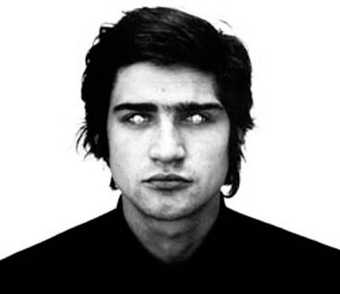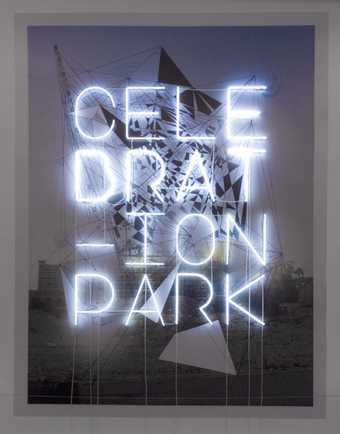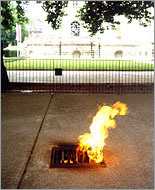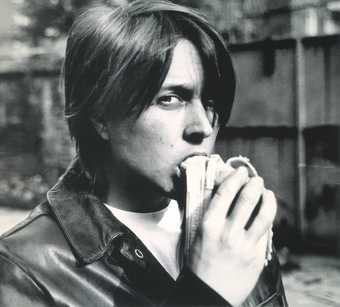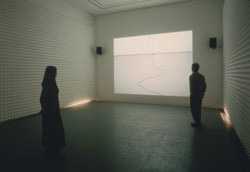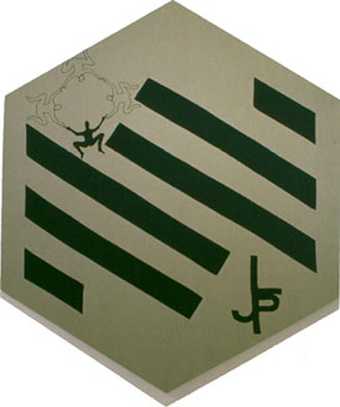
Fig.1
Keith Farquhar
John Lewis Partnership 2000
Courtesy of the artist
1. UK ↔ DJ
Yeah, I’d say all their work was informed by a crushingly naïve political viewpoint that could only have been nurtured in the bubble of an art school. I think the misfortune of that kind of art is that it’s politically imbecilic, and on an intellectual level they’re still living off the arguments of the Frankfurt school – Adorno and Horkheimer – from the Sixties. They argued that we are all slaves to something called dominant ideology; this bourgeois thing that was constructing our way of thinking for us, our politics and our society. Whereas the world we live in today is one that actually offers us much more choice to resist, rebel and construct our own community and I don’t think any of the artists in that programme have really taken that on board. The weakness of the art to me is that it is quite patronising actually. They’re trying to tell me something that I disagree with and they’re saying ‘Because we’re artists we know better’, and I think that’s one of the Modernist art myths they haven’t managed to get rid of.1 (Film director Ben Lewis on Relational Art, 2004)
Since the mid 1990s ‘relational aesthetics’ has become an increasingly popular neologism for a series of practices identified in contemporary art by French curator Nicolas Bourriaud, including the work of artists such as Philippe Parreno, Douglas Gordon and Rirkrit Tiravanija, Liam Gillick, Pierre Huyghe, Maurizio Cattelan, and Vanessa Beecroft. Bourriaud’s conception of practice is located in postmodernist developments that span back at least to the mid 1950s and which found widespread expression in the conceptual practices of the later 1960s and early 1970s. A customary postmodernist privileging of second order information is central to Bourriaud’s vision of the artist as a facilitator rather than a ‘maker’, a DJ rather than a performer. Bourriaud regards art to be a form of information exchanged between audiences. The artist, in this sense, gives audiences access to power, the means to change the world. Of course, as is the case in earlier forms of postmodernism, the means of changing the world lie in systems of representation. The crucial difference is that Bourriaud fixes on the economy as the key system of representation. To intervene in the economy in a practical sense might allow the artist to do something functional, to actually make a difference. Bourriaud, therefore, stresses the importance of utility, asking artists to put effects to work rather than simply remain with the safe realms of a critique of representation.
This call is not new, having numerous precedents in cybernetic and socially engaged practices of the early 1970s. In the United Kingdom this kind of practice was particularly important to critics such as Richard Cork, who curated a number of exhibitions and conferences on the theme of art for society at the end of the 1970s. Socially engaged practice continued to find a great deal of support in Scotland in the later 1980s and early 1990s, particularly among artist-inititives such as Transmission, which in the later 1980s was dominated by the free-university model, and from the Scotia Nostra graduates of Glasgow School of Art’s Department of Environmental Art. Bourriaud, for this reason, cites Douglas Gordon as a key player in the international development of relational aesthetics in the 1990s. Indeed, 1990s art in Glasgow is characterised by its strong links with ‘Eurocuros’ such as Bourriaud and Hans Ulrich Obrist, made through curators such as Charles Esche while he was curator at Glasgow’s Tramway. Although interest in this kind of work partially cooled off in Glasgow in the mid 1990s, it could still be seen in prominent exhibitions such as Transmission’s Never Been in a Riot (1998) – a culture-jamming show put together to celebrate the twentieth anniversary of the May 1968 uprisings – and The Modern Institute’s project with Rirkrit Tiravanija, Community Cinema for a Quiet Intersection (Against Oldenburg), as part of Glasgow’s City of Architecture festival in September 1999.
Despite the fact that it is largely a cultural moment that belongs to the 1990s, in the early years of this century relational aesthetics have caused a belated stir in certain sectors of British art, notably in London. There, a wave of parochial pride and cultural insularity encouraged by the public relations triumph of yBa prevented such networks becoming more visible until the end of the 1990s, with high profile exhibitions such as CRASH! at the Institute of Contemporary Art (1999) and Matthew Higgs and Paul Noble’s Protest and Survive at the Whitechapel (2000). Rebecca Gordon Nesbitt, Maria Lind and Obrist’s nomadic Salon 3, popped up over 1999 in Elephant and Castle Shopping Centre, providing a temporary space dedicated to migratory networked art. A series of exhibitions curated by MA students at the Royal College of Art: The Campaign Against Living Miserably (1998), Democracy! (2000) and Playing Amongst the Ruins (2001) suggested that a ‘new’ paradigm had finally become the official curatorial model for the English capital.
In fact, such activity had been around for some time in London, notably in the mail-based curatorial work of artist-curator Higgs (who was teaching curating students at the RCA in the late 1990s) and in the activities of Poster Studio and Scanner. Relational aesthetics in London were as much a means of survival for artists as curatorial proclivity. This way of working with information and mobile infrastructures was partly related to the problems of securing and maintaining permanent spaces in London, and partly an aesthetic reaction against the object-based spectacular big budget work of the earlier 1990s. In Manchester, where it was slightly easier to secure temporary property, the need for nomadic structures differed again. In November 1995, The British Art Show 4 opened in Manchester. Dominated by yBa and Scotia Nostra artists, the show featured no artists from the North West of England yet claimed to be representative of ‘British Art’. Further slighting the local populace, the show also took over all the available art venues in Manchester, where artists were employed as invigilators. In response to this slap in the face, Mancunian artists Martin Vincent and Nick Crowe decided to organise the warehouse show ha! in Little Peter Street. This gradually snowballed into The Annual Progamme, a loose agenda of temporary spaces and situational projects designed to encourage artists to work together and explore parts of the city that remained unfamiliar to them. In this spirit Graham Parker and David Mackintosh began to work collaboratively under the name Bono & Sting, performing a twenty-four hour table tennis match for charity and opening From Space in Salford: ‘I think the key thing is that we’re artists with a space rather than being an artist-run space, with the connotations that can carry.2
While particularly suited to low-cost nomadic venues, informatic curating was equally embraced by mainstream venues, as demonstrated by Rebecca Gordon Nesbitt’s Continuum001 at Glasgow’s Centre for Contemporary Art (2000) and Virginia Button and Esche’s Intelligence: New British Art 2000, the first Triennial held at Tate Britain. The newly rebranded Tate Britain had the difficult job of winning ‘contemporary’ audiences poached by Bankside’s Tate Modern. Intelligence was clearly drafted in response to the alleged dumbing-down popular in the 1990s yBa and magazine culture, a form of counterintelligence activity allowing artists to re-engage with ‘serious’ research and development. To some extent the exhibition combined irreverent works such as DON’T WORRY 2000, Martin Creed’s high-tech neon sign positioned outside the gallery, with illustrations of networked art that had been overlooked by London-centric accounts of contemporary British Art, such as Douglas Gordon’s List of Names 1990–2000, recounting as many of the people he can recall meeting (just over 3,000 in 2000). Much of the information presented in this sense, is open-ended or ambiguous, just as art audiences had come to expect. Intelligence also imagined reaching out to and interacting with imaginary audiences with all-source analysis works such as Patrick Brill’s Stop it Write Now! 2000, undertaking the community’s covert actions by asking ‘the public’ to invent new slogans for him to paint. The thorny question of the ‘British imaginary’ was raised by Jeremy Deller and Alan Kane’s research into modern folklore, the ethnographic Introduction to Folk Archive 1999 – an installation including ubiquitous Morris dancers, tattoos, a Jimmy Savile scarecrow, flower arrangements by the Women’s Institute, political demonstrations, a pipe-smoking competition at Egremont Crab Fair and ghost train mise-en-scène. In addition to sounding like a dodgy Pet Shop Boys bootleg, the vague ‘information/dialogue’ theme underlying Intelligence helped very little. Certainly, many of the works relied on controlled patterns and intellectual rigor. However the idea that art reaches a higher level by controlling its structure seems to have gone unquestioned. This was an evaluative stance, erroneously implying that only certain types of art are ‘intelligent’, and that mesmeric pleasures for their own sake are undesirable. The idea that British art was shifting towards propositional and taxonomic practices was refuted by the inclusion of yBa sculptors such as Sarah Lucas. Artists who seemed most suited to exhibition seemed equally irreconcilable. Susan Hiller surfed the radio waves to produce Witness 2000, a mixed-media sound installation of interwoven rhythmic patterns in shimmering detail. The mysterious, incantational impression produced by the multi-lingual recordings of UFO sightings suggesting that Hiller was using her anthropological research skills unsystematically, viewing them as techniques to use in an arsenal of expressive tools relating to dreaming, states of reverie, and the uncanny. The intelligence theme, then, was as thorough or all pervasive as the vaporous dry ice in Spill 1999, Graham Gussin’s ethereal film footage of a derelict warehouse. Having said this, Intelligence included some interesting work and was, by no means, a regretful inaugural triennial of British art. Clearly the problem lay with the issue of cultural branding in an increasingly saturated market, Tate Britain having to compete for official custody of ‘New’ British Art not only with Tate Modern, but with Becks Futures and the British Art Show 5. Given the internationalism of relational aesthetics, it was very difficult to combine this with the supposedly ‘Brit’ character of some of the works.
It has been key to exhibitions of relational art in Britain that they wear their internationalism on their sleeves, and that they show their awareness of their historical roots. Both of these characteristics assume an uncannily close relationship with modernism (internationalist and historicist). They must also be seen as a riposte to the parochialism of yBa, and as a return to curatorial centralism. While the parochialism of yBa may have seemed reactionary, in some senses it stemmed from the lack of resources available to young curators and artists. Turning attention towards the local was empowering to many artists. In contrast, relational art, while it has its roots in artist-led initiatives, quickly became linked to the nomadic curator, a figure who (net)works internationally. This has created an intense disdain in some cultural quarters, rejecting anything that might be read as insular as the Grand High Pooh-Bah of Parochial Autism. A linga franca of issues surrounding communication and the globlised economy has therefore the most often recurring theme of group exhibitions. Notable in this sense are Alex Farquharson’s The Communications Department (Anthony Wilkinson Gallery 2001), Gavin Wade’s STRIKE (Wolverhampton Art Gallery 2002), Rob Tuffnel’s Ill Communication: Advances in Travel and Communication (Dundee Contemporary Arts 2003) and Simon Pope’s touring exhibition Art for Networks (2003). Such exhibitions fit neatly with the themes of major international Biennales such as the 2002 Gwangju Biennale in South Korea, the 2002 Documenta, Ulrich Obrist, Molly Nesbitt and Rirkrit Tiravanija’s Utopia Station Poster Project at the 2003 Venice Biennale, and Ute Meta Bauer’s 2004 Berlin Biennale.
With increasing regularity the global community are now spoon-fed a staple fare of biennales structured around a restricted range of culturally invested portfolios inherited from 1980s critical postmodernism and 1990s theories of globalisation: the economy, the environment, utopia, gender, technology and urbanism. The desire to build bigger exhibitions (both in terms of their global conceptual ‘relevance’ and in their physical stature) aids globalist strategies of cultural recuperation and the growth of brandscaping art companies, rendering the ‘product’ largely meaningless and culturally monotonous. Of course, brandscaping played a central role in the construction and export of ‘British art’ in the 1990s, so much so that it such embarrassingly oversimplistic imaginaries are difficult to shake off. The late embrace of relational aesthetics by U.Kunstlers has been a last ditch attempt to create the illusion of cultural diversity and ‘timely’ internationalist ambition, making its neo-colonial aspirations more palatable by wrapping them in rhetoric about the need to protect the interests of the disadvantaged and the downtrodden.
2. IDEA ↔ IKEA
The title of this show [Early One Morning] expresses not only the quietly thrilling imminence of a new dawn, a sense of optimism and curiosity bound up in looking to the future; it also embraces the past.3 (Iwona Blazwick 2002)
While relational aesthetics continued dialogue with critical theory and the history of ‘socially engaged’ art practices as a means of rearticulating art’s role in the world, many artists and curators have busily proceeded in another equally historicised direction. Creating ‘feel good’ exhibitions designed to re-affirm the status of art and modernist myths of ‘intuitive’ working practices, the alleged ‘return’ of object making (did this ever stop?) seemed to go hand in hand with a time of increasing geopolitical instability and economic expansion. There are, however, other ideological reasons for the rise of what has been touted as a ‘new formalism’. The relationalism that proliferated at the turn of the early twenty-first century placed undue emphasis art as a technologically determined form of communication, tending to rule out the possibility that art might be made using ‘regressive’ techniques or that it might fail to signify.4 There are three main problems with this technist, causal view of art. Firstly, it assumes that we can determine our judgements of artistic intention on the evidence of objects alone when material effects and acts have no essential meaning other than those that we bring to them. Secondly, it allows little room for failure, or for the possibility that the most interesting things in art praxis emerge from mistakes.5 Indeed, artists working in Scotland and London have lately placed a great deal of emphasis on working practice, an emphasis that simply is not compatible with the idea of ‘professional practice’. Thirdly, there is the danger that the over emphasis on post-production and consumption-based culture will eradicate all trace of place and origin, of labour and of the social relations involved in production.
The ‘new formalism’ can be see as a broad based set of practices rooted in discursive and impure acts of performative ‘making’ rather than appropriational ‘taking’, the hand-made rather than the readymade.6 Emerging independently yet simultaneously in Scotland and London over the past ten years, such art was packaged as a triumphant new ‘New-Generation’ of sculpture by Early One Morning at the Whitechapel in July 2002. This exhibition was neatly sandwiched between Tate Modern’s Arte Povera retrospective in 2001 and Tra La La at Tate Britain, an the exhibition of New Generation 1960s British sculpture in Tate Britain, featuring the work of Anthony Caro, William Tucker and Phillip King.7 Both exhibitions were crucial to the packaging of the work of London-based Gary Webb, Shahin Affrassiabi and Eva Rothschild and Glasgow-based Claire Barclay and Jim Lambie at the Whitechapel exhibition. On the one hand, Arte Povera forms a key point of reference for the often shabby lo-fi quality of some of this work, while Tra La La allowed Early One Morning to claim these artists as ‘British’ exemplars of a global trend.
A number of precedents exist for Early One Morning as a way of reading ‘British’ sculpture, most notably in Lewis Biggs, Iwona Blaszczyk and Sandy Nairne’s Objects and Sculpture at the ICA and Arnolfini in 1981, which took the Lisson sculptors as a new generation of pop artists for the 1980s.8 This in turn was replicated by Material Culture held at the Hayward in 1997, which created a lineage between the 1980s Lisson Sculptors and the works of yBa and the Scotia Nostra. The key ingredient here is the implication that ‘sculptural values’ (conjuring up spectres of grown men arguing over whether or not a lump of steel should be set on a plinth or not) survives despite the postmodernist triumph of anthropological accounts of cultural practice and the vast changes that have taken place in the infrastructure of British art. None of the artists involved could be said to believe in the modernist sculptural ideology of ‘truth to materials’, although their works bare surface similarities.9 Tom Morton argues that whether or not
these five artists represent a coherent tendency is a moot point. Their work has a few cosmetic similarities, sure, but it also has more than its share of differences. The strongest link between the works is eagerness to square up to the past and explore what sculpture might mean today. These artists are not the heirs of Caro’s New Generation. No one is; art just doesn’t work like that any more.10
As Morton points out Early One Morning’s ‘Vasarian’ historicism is so unnecessary and unhelpful that it ought to be ignored in order to enjoy the ‘visual pleasure’.11
This raises a number of problems for critics who see this as simply being ‘complicit with a culture industry laundering “cool” as the prime currency’.12 For Paul O’Kane, the exhibition celebrated escapist attempts to reinforce traditional ‘autonomous’ sculptural values and attendant white, bourgeois sensibilities, the product of an artworld that has got ‘into bed with gentrification’13 and lifestyle Sunday Supplement culture. Certainly the surface qualities of Webb’s works reek of the neo-modernism found in much contemporary architecture, bar and hotel design. While the lyrical play with these visual tropes suggests a turn against research-based approaches committed to detourning material culture and museological spectacle as popularised by 1990s exhibitions such as Material Culture (1997), it amounts in part to a continuation of the meditation on (international) modernist architecture and design that fit well with the themes of a number of international shows focused on utopianism and post-minimalism.14 Formally speaking, Webb’s work makes sense, reworkings and reconsiderations of modernism corresponding directly with the preoccupation with neo-modernism in 1990s design: ‘To justify the zeitgeisty notion of “generation” promoted the accompanying literature the show reveals a few noticeable refrains. For example there is a similar tendency to assemblage and appropriation shared by Webb and Shahin Afrassiabi and Afrassiabi echoes Claire Barclay’s ‘Ikea’ – ‘Muji’ or ‘Habitat’ – inspired, clean, and machined timber.’15 Following Michael Bracewell, we could read the surfeit of brand new wood as a hangover from the ‘infantilism’ and ‘cocooning’ central to gentrified urban living in the 1990s Britain.‘16
You could throw in the importance to Interior Design in the 1990s of Midcentury Modern styling (the Fifties coming up in price) which was morphed with the brushed metal and bleached-oak effect of shop-fitting chic to create the basic Loft Look. Out of this came a kind of ‘Pod and Spike’ approach to Lifestyle – Pod being the cocooning impulse to feed on infantilism, and Spike being the exquisite good taste of the tamed avant-garde.17
If ‘Spike’ in the 1990s took the form of grunge and the faux-authenticity of yBa ‘screaming how fucked-up it and everything around it was’,18 by 2000 it had been fully eclipsed by the triumph of ‘Pod’.19
The 1950s revivalism of the ‘contemporary style’ in ‘Pod’ allowed the new formalism to be sold on to an international audience who are not concerned with the context in which it the work was created. If ‘Pod’ amounts to an ironised arrière-garde strategy, it is one that draws as much the contingencies of the nineties critique of the contemporary (neo-modernist) built environment as it does on 1960s sculpture.20 In its predeliction for ‘Pod’ styling, the new formalism has its bedfellows, most strikingly in the architecture and furniture found in much gallery-based relational art, in Liam Gillick’s ‘scaled-down models of communicational situations’21 and in the ubiquitous discursive ‘platforms’ rolled out at Biennales around the world. Of course, such structures are primarily functional and not intended to be viewed for their formal qualities. However, there is a clear sculptural hangover in the tendency for many Eurocuros to employ artists, designers and architects to design exhibitions and platforms as Gesamtkunstwerk. Given that form is supposedly subordinate to function in such exhibtitions, it’s little surprise to find that, more often than not, a stripped-down Shaker-style neo-modernism is the style of choice.
Neo-modernism is but one stylistic genre of the new formalism. Far richer in formal allusion than the work of Gillick, the lyrical qualities of the works in Early One Morning at least allowed other critical relationships to emerge if the viewer allowed them to. The process of compelling conviction is presented rather than blocked or deconstructed, and can still take place if the viewer is willing to take the chance to ritualise their surroundings. Lambie’s optical floor work, Zobop 1998 can be seen as a purely ocular spectacle, or as a critical reworking of Minimalism, purging the earlier movement of its purity. This opens up creative re-readings of Minimalist repetition as a form of psychedelic incantantion, a performative rite rather than an everyday social practice.
The idea that object-based exhibitions can be formulated around ‘psychological association rather than historical category’ formed a major trope of The Modern Institute exhibition My Head is on fire but my heart is full of love, Charlottenburg Museum, Copenhagen, April 2002.22 Following this line of association, the exhibition suggested that we might find common ground in the work of minimalists such as Sol LeWitt, mystics such as Paul Thek and contemporary artists such as Lambie, Mark Handforth, Simon Periton and Piotr Uklanski.23 As a means of avoiding the closures of historicism, the works in Early One Morning might just have easily have been curated around other newly fashionable aspects of the 1960s and 1970s Carnaby ‘over the counter-culture’ rather than the comparatively docile world of modernist sculpture.24 The works obviously draw on cultural studies and culture in its widest sense as much as they might upon the history of British ‘sculpture’.
Artists featured in Early One Morning have been fielding their own psycho-cultural readings of their work in very different contexts for many years. In a series of London exhibitions at the turn of the century v Painting Lab (1999, Entwistle Gallery, London), Abstract Art (2000, Delfina, London), Nouveau Riche (2000 with Keith Farquhar, The Approach, London) and The Dirt of Love, (2001 with Roger Hiorns) – Webb exhibited with artists who shared his witty love of materials and the poetics of the urban environment. Featuring the quasi-abstract work of Webb, DJ Simpson and Keith Farquhar among others, Abstract Art was a particularly prescient thesis regarding the terms upon which artists were willing to engage: ‘We’re allowed to mention abstract art again, without recourse to inverted commas or a patrician snobbery. It’s back, but slightly different; where once abstraction was essentially polarised into ironical and sentimental modes, now the two can co-exist.’ (Martin Herbert review of Abstract Art, 2000)25
Farquhar’s works produced with his mother were indeed torn between the sentimental and the hard-edged. John Lewis Partnership, 2000 (fig.1) represents the colours of the department store sewn by Mrs Farquhar to produce a lozenge shaped stereochromatic canvas, a romantic eulogy to the homespun, materialism and partnership. Reviewing the exhibition, Martin Herbert noted that Webb’s deliberately overdetermined assemblage of forms and materials functioned as ‘an exercise in sending the mind of several wild goose chases simultaneously’,26 while Lambie suggests that his use of encultured materials ‘allows the object a more multi-layered reading, that there aren’t such hard-edged parameters on the work, that it isn’t just about one thing, and that most people could find a way into the conversation.’27 This praise of multiple slippery signifiers is a reoccurring motif in the positive reception of the work’s ‘rich seams of ambivalence […] integral to their source’28 and its ‘non-unitary, multi-perspectival’,29 polyphonic and multivalent qualities, all value judgements that are as rooted in romanticism as they are in poststructuralism. As was the case with yBa, art theory plays an ambiguous supporting role here, informing a vague commitment to open ended rhizomatic interpretive possibilities, while taking a quasi-modernist back seat to the oracular and the role of ‘making’.30 This is perhaps another hangover of Sixties Britain, the Dr Jekyll and Mr Hyde relationship between critical ‘theory’ and studio ‘practice’ that many conservatives have tried to pin on the 1960 Coldstream Report. The real danger, as Nick Evans notes, is that the, ‘refusal on the part of artists to signify, or on the part of commentators to exploit the significatory potential that does exist within the work plays heavily into the hands of the right leaning political status quo. […] This slave-like adherence of the new formalism to its Derridean inheritance is frustrating.’31 As Evans rightly suggests, nothing new emerged in the ‘new’ formalism. All we were witnessing was a recycled postmodernist line in rhetoric designed to instate a simulacra of ‘making’ at the heart of contemporary art practice.
As Gemma de Cruz noted in 2000, the ‘outburst of craft being incorporated into painting, came not as an alternative but as a new component, forcing itself to be accepted’.32 By the end of the 1990s, the use of craft skills and materials could be seen readily in the work of London-based artists such as diverse as Simon Periton, Jeremy Deller, David Burrows and Enrico David. In many cases, reciprocal relationships between Glasgow and London based artists and dealers allowed a dialogue of sorts to emerge between the two cities. Martin McGowan of London’s Cabinet Gallery and Glasgow’s The Modern Institute led the way in commercially packaging this trend in the exhibition Lovecraft which opened at Glasgow’s Centre for Contemporary Arts in 1998 before touring to the South London Gallery. The Showroom in London was home to solo shows by Lambie, Barclay and Rothschild between the summer of 1999 and 2001.
While such galleries were highly aware of the nuances that living and working in different cities could bring to this craft orientated practice, in Early One Morning, Scottish art arguably suffered colonial appropriation by Iwona Blazwick and Andrea Tarsia’s dormant London-centric art history. In Glasgow, the kind of ‘sculptural’ practices that Blazwick and Taria regarded as being informed by the St. Martin’s School had long been integrated with an ongoing saga of ‘awkward authenticity’, a major trope of Glaswegian urban culture spanning music, fashion, art, literature and film.33 Such art was the product of vernacular moblisation, a locally-based (albeit globally recursive) desire to create convincing differentiated and sustainable cultural bases. In many ways this is linked to the logistics of funding in Scotland where spatial and financial limitations encourage a mixture of art, music and performance and a nomadic approach to space. It is particularly difficult to imagine how the work of Barclay and Lambie could have developed in quite the same way outwith these conditions.34 Barclay and Lambie’s awkward authenticity was generated and safeguarded within a body politic defending the right to make mistakes and engage in forms of purposeless production and esoteric consumption denigrated by hegemonic entrepreneurial culture.35
The idea that the work might be a critique of mass production and consumerism in line with Arte Povera or the 1980s sculpture of Bill Woodrow, is raised by the references to new age mysticism in the work of Barclay and Rothschild and in Lambie’s recycling of charity shop materials. Webb goes as far as suggesting that this might even be political: ‘There is definitely frustration in there about capital and environmental problems, like pollution. These materials all come out of mass-production – where does it all go, where does this stuff all end up, all the chemicals and oils that are used to produce this stuff?’36 As is the case with much relational art, the political will mondestrated here is illustrative at best, naïve and incoherent at worst. By producing plastic sculptures, Webb is part of the environmental problem rather than the solution. The only way in which the work might be thought to function critically is in relation to the perceived hegemony of market-driven culture. J.J. Charlesworth’s argues that this is an ‘art that is idiosyncratic and resistant to assimilation into other forms of visual culture.’37
While Charlesworth is right to stress the importance of the ‘atmospheric, idiosyncratic and allusive’ refusal to signify as a (largely tepid) form of ‘resistance’ to mass mediated culture, he mistakes this for a defence of ‘sculptural’ autonomy, forcing art into an imaginary ocular ghetto. The art associated with a ‘new formalism’ has been resolutely intermedia and much of it sound and language-based, being inseparable from the symbiotic development of highly nuanced contexts and infrastructures in Scotland and London.38 Blaswick’s stress upon loosing contact with the outside world in order to become ‘indoctrinated into the internal logic of the work of art’, nevertheless holds a little vapour.39 What is being cosseted is a stress upon the communicative possibilities of parochial language games and role-playing. Glasgow-based artist Alex Pollard relates this to languages ‘developed by people outside of sublimated behaviour, like thieves or gay Palare. These languages are usually invented to communicate within a group, excluding those outside the set of rules. I like the idea that expression is still possible and that these groups are romantic and elitist.’40 Keith Farquhar, again living in Edinburgh, correspondingly has culled for his working process the phrase ‘blindcraft’, ‘setting up an idiosyncratic faith system after noticing that the bed I was sleeping in in my rented flat was made by the local blind who’s centralised factory outlet sells to the public under that name.41 A form of self-legitimating consciousness, such art can only really be appreciated by those involved intimately with its production and reception. It encourages cultural commitment, mitigates larger audiences and, for a while, provided few points of access for curators needing to fulfil educational programmes.
The cultural potential of this work has been mired by its historicist packaging as a ‘new formalism’, allowing the work to be overpowered by sycophantic artfans inspired by quasi-mystical proclamations of autonomy. Thanks to Early One Morning Jim Lambie’s work can easily be damned as simply being ‘complicit with a consensus of cool.’42 If awkward authenticity is ‘a way to produce a kind of faith’,43 then it can only be so amongst a small group of converted parishioners. Glasgow-based artist Nick Evans notes that it is
more as if the use of such [new age] signs allows the [awkwardly authentic] artist to summon up a notion of the artworld as a ‘totemistic’ community, where through the process of an art education and shared sets of cultural and class values, artists and art lovers may develop a kinship between all things in the ‘artworld cosmos’.44
Awkward authenticity is illocutionary, reliant upon having faith in the self-authenticating gestures of Glasgow artists. Evans is not alone in his frustration at the apparent lack of tolerance or space for critique present in what seems to have become the orthodoxy of ‘cultural faith’ in Glasgow. The manifest ‘totemistic’ qualities of awkwardly authentic tendencies to be found in Glasgow art are far from dominant and have fewer followers in other Scottish cities, yet the shambling Glasgow Style remains brawny, buttressed by growing markets generated by The Modern Institute and Zenomap Scotland’s pavilion at the 2003 Venice Biennale.45 Despite this, the supposedly perpetual ‘frailty’ of Scottish art, (or is it whimsy?), is often held as a reason not to rock the boat by voicing critical dissent towards any aspect of practice. Evans is right to rally against mystification and knows that so doing there is the danger of supporting the functionalist demands made upon artists by the Scottish Executive and relationalism. The greater danger is that the basic building block of Scotland’s grassroots art culture, trust, might be exploited as style rather than as a means to speculate critically on the difficult, messy and potentially fraudulent. Whether curatorial packages such as Early One Morning, the lure of the private market in London and Glasgow, or the vagaries of prize fights such as Becks Futures will finally put an end to the kind of experimentation found in Scotland remains to be seen.
The doubts concerning the ‘intentions’ and critical credibility of the new formalism will continue to raise difficult questions concerning artistic production. Social functionalism continually stresses that relationalism is a means of working with the post-industrial economy. For British disciples of Bourriaud, their belief that the economy is largely based on the exchange of information makes ‘object’ or ‘craft’ based art designed for ‘independent and private space’46 redundant, a product of the industrial past. Leaving aside the contentious claim that the global (never mind the British) economy is post-industrial, is it possible to positively evaluate Early One Morning using Bourriaud’s ‘co-existence criterion’?47 None of the artists included in the exhibition could be said to be wholly complicitous with a ‘totalised’ industrial mode of production. Webb employs industrial processes in his work, but does so on a cottage scale. Lambie makes most of his work himself inititally but then uses assistants to complete his work. None of the artists could be said to comply with a serial or assembly-line process. Rather, they comply with the dominant global production system: ‘just in time’.
By the beginning of 2003, Lambie’s art was in such demand that it had to be produced on the roll, obliging him to work to order. Lambie responds the environment efficiently, picking up materials at charity shops in the locale of the gallery he is working in and responding to the peculiarities of the site/market. While Lambie left the twentieth century enjoying the pleasures of a ‘return’ to making by hand, his success has necessitated working to very strict deadlines, tightly packaged ‘site-specific’ briefs, and increasingly demanding and escalating orders from a global marketplace of galleries and biennales. In this sense, it is difficult to see any punitive ‘escape’ from the post-industrial globalised world of work. Lambie’s predicament is far from unique. On the contrary; whether or not they adhere to the false dichotomies of ‘new formalism’ or ‘new functionalism’, today’s global artists keep up with the world’s future cultural needs by embracing the just in time delivery system. In so doing, the values of speed, disposability and instant gratification become their awkward relations.

